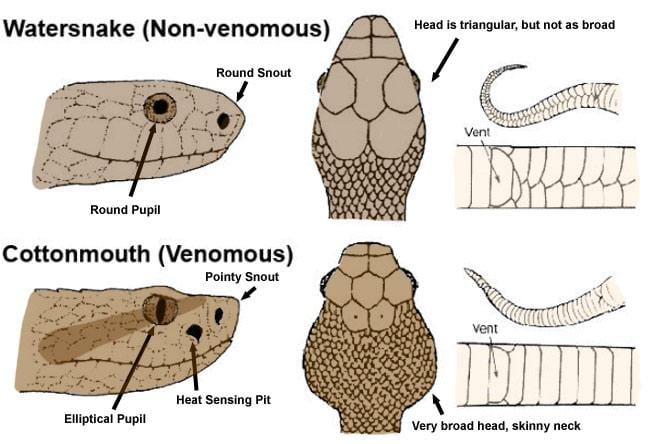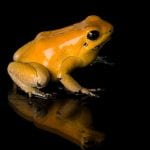There are various ways that people identify snakes, and some of this involving the myths and the different poisonous and non-poisonous characteristics, as well as snake classification depending on body type. Here are various tips that you can observe for identifying snakes.
True Or False: Venom Factor Depending On Pupil Shape
In this principle, it is believed that all snakes with slit-shaped pupils are venomous. But, not all poisonous snakes have slit-shaped pupils. Another problem with this identification technique is that you still have to get close to the snake in order to find out.
In reality, snake experts follow a methodological system that helps them categorize and identify what a snake is once it has been found.
Identifying Snakes Through Their Body Length, Eyes, and Head Shape

Snakes are basically categorized using three classes: small, medium, and large. After measuring the length of the snake, you can also determine the snake’s width. If it is possible, the best way to go is to identify the actual dimensions.
The head of the snake can also be helping to tell a lot about the snake, but this does not really mean that it can influence anything that is related to non-venomous and venomous snakes. There are many pit vipers that have triangular heads, but this angular shape can also be seen in some snakes which accidentally deform their head when they are anxious or stressed.
But, knowing the shape of the snake’s head can effectively help you to gain the identification of the snake. It can be round, long, or oval-shaped. You should also note the pupil shape, eye color, eye size, and the location of the eyes on your snake’s face. Going with the three main identifiers, namely, eye characteristics, head shape, and body length and width would definitely help with species identification.
The Importance Of A Snake’s Color

To determine the type of snake that you encounter, one powerful factor is a snake’s color. Colors are also closely influenced by patterns. If you note the colors and patterns, you might be able to identify a harmless snake from a poisonous one. But, it can be hard to differentiate one from another. Blotches can also refer to patterns that do not have symmetry. These markings are often rectangularly partnered with darker edges. If there is a diamond pattern present, the color and color pattern must be found as well.
Once you see the snake, as yourself this: are there speckles and flecks of color in your snake? Are the spots looking like solid color circles? Are the spots small or large? Are there ring patterns that look like bands? You might notice that ring patterns encase the width of your snake while stripes travel lengthwise on the body of your snake.
Watch the color contrasts of your snakes, as there are many snakes that have one color on their dorsal sides and a different color on their bellies. But, you might also see that some snakes have one specific solid color.
Identifying Snakes With Their Tails
Tail characteristics are another guide that you can use to identify a snake. A snake’s tail can be defined as the length of the snake’s body that is stretching from beyond the anus of a snake. Some snakes also have tails that end with a rattle. Some tails are rounded while some are pointed. Some of them even come with specific patterns. When the snake is turned over, you can check if the scales under their behinds are single or divided?
For a deeper identification process of snakes, you can use the arrangement and the exact number of scales in the snake.
Once you have gathered all the forms of information that you can, you can have a snake field guide to help you narrow down your total list. The characteristics that you can note will be able to pinpoint one or maybe a few species suspected. Some snakes are almost identical, and it is these things that require habitat evaluation and assistance.
If the snakes cannot be identified by their appearance alone, the habits of these snake species will come into play. There are snakes that prefer some sand and some like rocky soil. Some snakes eat specific animals, while some snakes will eat anything that comes their way.
Here are sample characteristic points that you can use:
- Uniform Colors – They are solid colors that can be blue, black, green, brown, tan, orange, yellow, gray, without having any form of markings. On some snake species, the color on their skins can be darker on their neck and head, and it will become much lighter on the back part of their body.
- Speckles – Speckles are small flecks of color. Depending on the species, there can be on, or more speckles found on each snake scale.
- Stripes – Stripes are narrow lines of color that can be seen running lengthwise down the body of a snake. Some stripes are only wide as one scale, but they can also be several scales wide.
- Spots – Spots are small rounded marks, and they usually dare not lined with a border. They may cover several scales or just a few ones.
- Crossbands – These are seen as bands of colors that extend across the back and down the sides of a snakes body, but are not seen in a snake’s belly. The belly of these snakes is frequently colored with a light color that contrasts the color of the crossbands.
- Blotches – Blotches appear as irregularly shaped markings that appear like large squares and are bordered with dark colors.
- Rings – Rings look a lot like crossbands, but these bands extend across the backs of these snakes, down their sides, and even across their bellies. Rings completely encircle the body of the snake.
- Diamonds – Diamonds appear as slightly overlapping blotches with recognizable diamond shapes. They run down the middle of the back of the snake. Usually, they usually have dark borders or light and dark borders.
- Smooth Scales – Smooth scales feel like surfaces that reflect the light. If you are not sure that the snake has smooth scales, you will be able to see shiny, glossy, and iridescent color patterns all over its body.
- Keeled Scales – These scales appear to be dull and appear with a no-gloss surface. If you are feeling unsure, look at your snake and see if it has lost its shine with a dusty color pattern while also being drab and dull.
A Quick Snake Identification Guide Example
- If a snake has round pupils and no heating sensing pits, it is harmless.
- If a snake has vertical pupils and if it has heat-sensing pits, it is venomous.
- If a snake has vertical pupils, with heat-sensing pits, with dorsal scales on the head, and if it has a rattle, the snake most probably is a timber rattlesnake.
- If a snake has vertical pupils, with heat-sensing pits, with dorsal scales on its head, without any rattle, then the snake can be a Northern Copperhead if it has reddish to light brown with darker hourglass-shaped cross bands.
- If the snake has vertical pupils, with heat-sensing pits, with dorsal scales on its head, without any rattle, with a body that is colored black to olive with some brown stripes on its head, it most probably is an Eastern Cottonmouth.
- If a snake has round pupils and no heating sensing pits, with an upturned and pointed nose, it most probably is an Eastern Hog-nosed Snake.
- If the snake has round pupils, no heating sensing pits, with lateral stripes on its scales rows 3 and 4; it most probably is a Common Ribbonsnake.
- If the snake has round pupils, no heating sensing pits, with lateral stripes on its scales rows 2 and 3; it most probably is an Eastern Garter Snake.
- If the snake has round pupils, no heating sensing pits, with no preocular scale and a loreal scale, it most probably is a Rough Earthsnake.
Final Thoughts: How Would You Identify A Snake & Whether It Is Dangerous?
There is no quick answer and no hard or fast rule to be able to identify a dangerous snake from a harmless one. If you are an untrained observer, you might not be able to find a positive identification in any type of snake. The general rule that you must commit to is that you should be cautious of any snake that you encounter and avoid coming into contact with any snake if you do not have any form of experience.
There are different types of snakes, and they do exhibit specific distinguishing features and behaviors that will make it extremely hard to tell each snake apart from each other. If you are residing in or just visiting in an area where snakes are much common, it is very important that you at least attempt to familiarize yourself with the different characteristics of local snakes that you might encounter.



